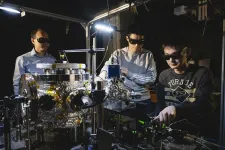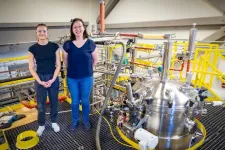(Press-News.org) COLUMBUS, Ohio – Parent size and the conditions in which actively spawning adults lived are the most influential factors affecting growth of Lake Erie walleye, a new study has found.
The findings surprised the scientists, who expected recent temperatures and food availability to have the highest impact on walleye growth.
Cold winters and more sizable mothers were associated with faster growth in 3- to 5-year-old walleye offspring, the analysis showed, suggesting that warmer winters that come with climate change might lead to future generations of smaller fish.
The findings also may mean ecological research in other species should take parental experiences into account to better understand animals’ present health, researchers say.
“We really did think that the recent environment would have the strongest effects,” said lead author Zoe Almeida, who completed the work as a PhD student in evolution, ecology and organismal biology at The Ohio State University. “When you’re thinking about factors that affect growth, you think you have to account for temperature and prey. And in reality, those signals were so small themselves that they weren’t the strongest in any way. It was very surprising.”
The study was published Aug. 13 in the Journal of Animal Ecology.
The pace of growth is used in research as an indicator of overall health in many species – and is influenced not only by experiences, but also genetics. By any measure, the current status of the Lake Erie walleye population is considered quite robust, according to the 2024 status report from the Ohio Division of Wildlife (ODNR-DOW).
“The Lake Erie walleye population is doing fantastic right now,” said Almeida, now a senior research associate in natural resources and the environment at Cornell University. “But is there something going on behind the scenes we’re not noticing, or that we won’t notice until much later because we don’t realize its effects?”
In pursuit of an answer, Almeida and colleagues made use of the wealth of walleye data generated by ODNR-DOW through its longtime monitoring of the Lake Erie population.
The team analyzed five factors that can affect growth: recent environmental conditions, such as food supply and temperature; previous year traits, including growth; population density that could indicate the extent of competition early in life; early-life body size; and parental conditions and environmental experiences.
The analysis was done on annual cohorts using data of walleye populations that were 3 to 5 years old in each year between 1982 and 2015, an age when they’re reaching maturity, but still growing rapidly. ODNR-DOW data also indicated the proportion of walleye that were spawning each year. Researchers explored relationships between these factors and cohort growth using statistical modeling.
“We parsed all that out and what was affecting the growth on a cohort level was really what happened to the parents,” Almeida said. “The size composition and winters they experienced determined whether or not the cohort was faster growing or slower growing than typical in the year before in individuals 3 to 5 years old.”
Meanwhile, no big impact on growth could be traced to the expected factors: recent prey, temperature and fishing pressure (anglers are the walleye’s main predator). This is not to say they had no effect – their effects were just not the most influential, she said.
The findings have implications for wildlife management and ecology research.
“It helps us set our expectations and understand the mechanisms behind things going on out there. When managers are thinking about what this population is going to look like in three to five years, they ideally will acknowledge the fact that what happened in the past is affecting them and keep that in mind when they’re making their management decisions,” Almeida said.
“And I do think that it has implications for other animals because what happens in early life or what happened to parents might be more influential than what is happening currently in their environment. And we’re not accounting for that.”
This work was supported by the National Science Foundation, a Distinguished University Fellowship from Ohio State, the American Fisheries Society, the International Association of Great Lakes Research, and the Federal Aid in Sport Fish Restoration Program administered jointly by the U.S. Fish and Wildlife Service and ODNR Division of Wildlife.
Co-authors were Stuart Ludsin and Elizabeth Marschall of Ohio State, and Matthew Faust of ODNR.
#
Contact: Zoe Almeida, zoealmeida@cornell.edu
Written by Emily Caldwell, Caldwell.151@osu.edu; 614-292-8152
END
The U.S. Department of Energy’s (DOE’s) Office of Fossil Energy and Carbon Management (FECM) has selected Texas Tech University as one of nine university and industry-led projects to split $44.5 million in federal funding to advance commercial-scale carbon capture, transport and storage across the U.S.
With an award just over $6.2 million, Texas Tech intends to implement and accelerate the equitable and environmentally responsible deployment of storage-based carbon management projects in the Permian Basin. The team will provide technical and engagement support for stakeholders to develop a framework ...
Digital wallets — like Apple Pay, Google Pay and PayPal — are projected to be used by more than 5.3 billion people by 2026. While these wallets promote increased security over traditional payment methods, reliance on outdated authentication methods and prioritizing convenience over security leaves digital wallets vulnerable, according to new research led by computer engineers at the University of Massachusetts Amherst.
“What we have discovered is [that] these digital wallets are not secure,” says Taqi Raza, assistant professor of electrical and computer engineering and an author on the paper. “The main reason is that they have unconditional trust between ...
INDIANAPOLIS – Indiana University School of Medicine researchers have made significant progress in understanding how cells communicate during inflammation. The study, recently published in PNAS, was conducted over a period of five years and focused on the molecules that enable cells to function during inflammation, particularly in the central nervous system where diseases like multiple sclerosis occur.
“Communication is key in any relationship, even at the level of cells that cause disease,” said Mark Kaplan, PhD, chair of the Department of Microbiology and Immunology at the IU ...
Physicists at Purdue are throwing the world’s smallest disco party. The disco ball itself is a fluorescent nanodiamond, which they have levitated and spun at incredibly high speeds. The fluorescent diamond emits and scatters multicolor lights in different directions as it rotates. The party continues as they study the effects of fast rotation on the spin qubits within their system and are able to observe the Berry phase. The team, led by Tongcang Li, professor of Physics and Astronomy and Electrical and Computer Engineering at Purdue University, published their results ...
The churning of the upper ocean in the tropics of Atlantic Ocean plays a crucial role in shaping long-term climate patterns across the world, a new study has found.
Researchers have discovered that changes in the ocean's mixed layer - the topmost section where wind and waves blend warm surface waters with cooler depths - are the primary force behind a climate phenomenon known as Atlantic Multidecadal Variability (AMV) in the tropics.
The AMV has far-reaching effects on global climate. It influences weather patterns from North America to Europe and Africa, affecting everything from hurricane ...
The Association for Psychological Science (APS) and Sage announce the launch of Advances in Psychological Science Open, a fully open access journal that will publish high-quality empirical, technical, theoretical, and review articles, across the full range of areas and topics in psychological science. The journal will accept submissions in a variety of formats, including long-form articles and short reports, and APS is encouraging scientists to submit integrative and interdisciplinary research articles.
“APS is always working to identify new ways to catalyze advances in psychological science,” said APS CEO Robert Gropp. “We are excited to announce ...
In the wake of the $51 million funding announcement from the Economic Development Administration, momentum is tangible for the Illinois Fermentation and Agriculture Biomanufacturing (iFAB) Tech Hub. Today marks the beginning of a new collaboration to replace fossil fuel-derived petrochemicals with zero-emission alternatives produced through precision fermentation.
Industrial Microbes (iMicrobes) is partnering with the iFAB Tech Hub’s Integrated Bioprocessing Research Laboratory at the University of Illinois Urbana-Champaign to harness microbes to produce acrylic acid, a versatile chemical ...
India's plans to scale up fracking operations without robust regulations could spell disaster for the country's finely balanced water security, according to research from the University of Surrey.
India is positioning shale gas as a key transitional energy source and has announced 56 fracking projects across six states. Despite the promise of energy independence, Surrey’s study raises alarm bells about the country's preparedness to handle the unique water risks posed by fracking.
Hydraulic fracturing, or fracking, involves injecting high-pressure fluid into shale ...
New York, August 14 2024 – A study published in the journal iSCIENCE has uncovered significant findings related to the early sensorimotor features and cognitive abilities of toddlers who are later diagnosed with Autism Spectrum Disorder (ASD). The research, led by Kristina Denisova, a professor of Psychology and Neuroscience at the CUNY Graduate Center and Queens College, takes an important step toward better understanding ASD so that more precise, individually tailored interventions can be developed.
Autism Spectrum Disorder, typically diagnosed around the ages of 4 to ...
Breast cancer remains a significant health concern worldwide, with diverse molecular subtypes that necessitate personalized therapeutic approaches. Recent advances have highlighted the importance of molecular signatures in guiding breast cancer treatment. Among these, the phosphatidylinositol-4,5-bisphosphate 3-kinase catalytic subunit alpha (PIK3CA) gene mutation has emerged as a crucial factor in determining the efficacy of targeted therapies, particularly in advanced breast cancer. This review explores the role of PIK3CA mutation detection in breast cancer and its implications for personalized treatment strategies.
Breast Cancer Heterogeneity
Breast ...


